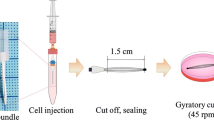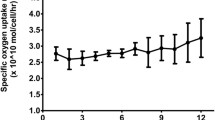Abstract
Bioartificial liver (BAL) based on microcapsules has been proposed as a potential treatment for acute liver failure. The bioreactors used in such BAL are usually expected to achieve sufficient flow rate and minimized void volume for effective application. Due to the superiorities in bed pressure drop and operation velocity, magnetically stabilized fluidized beds (MSFBs) show the potential to serve as ideal microcapsule-based bioreactors. In the present study, we attempted to develop a microcapsule-based MSFB bioreactor for bioartificial liver device. Compared to conventional-fluidized bed bioreactors, the bioreactor presented here increased perfusion velocity and decreased void volume significantly. Meanwhile, the mechanical stability as well as the immunoisolation property of magnetite microcapsules were well maintained during the fluidization. Besides, the magnetite microcapsules were found no toxicity to cell survival. Therefore, our study might provide a novel approach for the design of microcapsule-based bioartificial liver bioreactors.




Similar content being viewed by others
Abbreviations
- BAL:
-
Bioartificial liver
- MSFB:
-
Magnetically stabilized fluidized bed
- DC:
-
Direct current
- S w :
-
Swelling degree
References
Palakkan AA, Hay DC, Anil Kumar PR, Kumary TV, Ross JA (2013) Liver tissue engineering and cell sources: issues and challenges. Liver Int 33:666–676
Ding YT, Shi XL (2011) Bioartificial liver devices: perspectives on the state of the art. Front Med 5:15–19
Yu CB, Pan XP, Li LJ (2009) Progress in bioreactors of bioartificial livers. Hepatobiliary Pancreat Dis Int 8:134–140
Chan C, Berthiaume F, Nath BD, Tilles AW, Toner M, Yarmush ML (2004) Hepatic tissue engineering for adjunct and temporary liver support: critical technologies. Liver Transplant 10:1331–1342
Legallais C, David B, Dore E (2001) Bioartificial livers (BAL): current technological aspects and future developments. J Membr Sci 181:81–95
Carpentier B, Gautier A, Legallais C (2009) Artificial and bioartificial liver devices: present and future. Gut 58:1690–1702
Chamuleau RA, Poyck PP, De Kerkhove V (2006) Bioartificial liver: its pros and cons. Ther Apher Dial 10:168–174
Gautier A, Ould-Dris A, Dufresne M, Paullier P, Von Harten B, Lemke HD, Legallais C (2009) Hollow fiber bioartificial liver: physical and biological characterization with C3A cells. J Membr Sci 341:203–213
Dixit V, Gitnick G (1996) Artificial liver support: state of the art. Scand J Gastroenterol Suppl 220:101–114
Dixit V, Gitnick G (1998) The bioartificial liver: state-of-the-art. Eur J Surg 164:71–76
Lim F, Sun AM (1980) Microencapsulated islets as bioartificial endocrine pancreas. Science 210:908–910
Zimmermann H, Ehrhart F, Zimmermann D, Müller K, Katsen-Globa A, Behringer M, Feilen P, Gessner P, Zimmermann G, Shirley S, Weber M, Metze J, Zimmermann U (2007) Hydrogel-based encapsulation of biological, functional tissue: fundamentals, technologies and applications. Appl Phys A Mater Sci Process 89:909–922
Stange J, Mitzner S (1996) Hepatocyte encapsulation-initial intentions and new aspects for its use in bioartificial liver support. Int J Artif Organs 19:45–48
Hang H, Shi X, Gu G, Wu Y, Gu J, Ding Y (2010) In vitro analysis of cryopreserved alginate-poly-l-lysine-alginate-microencapsulated human hepatocytes. Liver Int 30:611–622
Lv G, Zhao L, Zhang A, Du W, Chen Y, Yu C, Pan X, Zhang Y, Song T, Xu J, Chen Y, Li L (2011) Bioartificial liver system based on choanoid fluidized bed bioreactor improve the survival time of fulminant hepatic failure pigs. Biotechnol Bioeng 108:2229–2236
Desille M, Mahler S, Seguin P, Mallédant Y, Frémond B, Sébille V, Bouix A, Desjardins JF, Joly A, Desbois J, Lebreton Y, Campion JP, Clément B (2002) Reduced encephalopathy in pigs with ischemia-induced acute hepatic failure treated with a bioartificial liver containing alginate-entrapped hepatocytes. Crit Care Med 30:658–663
Meuwly F, Ruffieux PA, Kadouri A, Von Stockar U (2007) Packed-bed bioreactors for mammalian cell culture: bioprocess and biomedical applications. Biotechnol Adv 25:45–56
Hwang YJ, Kim YI, Lee JG, Lee JW, Kim JW, Chung JM (2000) Development of bioartificial liver system using a fluidized-bed bioreactor. Transplant Proc 32:2349–2351
David B, Dore E, Jaffrin M, Legallais C (2004) Mass transfers in a fluidized bed bioreactor using alginate beads for a future bioartificial liver. Int J Artif Organs 27:284–293
Pless G, Sauer I (2005) Bioartificial liver: current status. Transplant Proc 37:3893–3895
Guo P, Huang F, Huang Q, Zheng C (2012) RETRACTED: biodiesel production using magnetically stabilized fluidized bed reactor. Renew Energ 38:10–15
Liu CZ, Wang F, Ou-Yang F (2009) Ethanol fermentation in a magnetically fluidized bed reactor with immobilized Saccharomyces cerevisiae in magnetic particles. Bioresource Technol 100:878–882
Goosen MF, O’Shea GM, Gharapetian HM, Chou S, Sun AM (1985) Optimization of microencapsulation parameters: semipermeable microcapsules as a bioartificial pancreas. Biotechnol Bioeng 27:146–150
Legallais C, Doré E, Paullier P (2000) Design of a fluidized bed bioartificial liver. Artif Organs 24:519–525
Liu CZ, Wang F, Ou-Yang F (2009) Ethanol fermentation in a magnetically fluidized bed reactor with immobilized Saccharomyces cerevisiae in magnetic particles. Bioresour Technol 100:878–882
Brady D, Nigam P, Marchant R, McHale L, McHale AP (1996) Ethanol production at 45 °C by Kluyveromyces marxianus IMB3 immobilized in magnetically responsive alginate matrices. Biotechnol Lett 18:1213–1216
Bahar T, Çelebi SS (2000) Performance of immobilized glucoamylase in a magnetically stabilized fluidized bed reactor (MSFBR). Enzyme Microb Technol 26:28–33
Huang XB, Wang JZ, Xie HG, Zhang Y, Wang W, Yu WT, Liu Y, Ma XJ (2010) Microcapsules embedded with three-dimensional fibrous scaffolds for cell culture and tissue engineering. Tissue Eng Part C Methods 16:1023–1032
Ma Y, Zhang Y, Wang Y, Wang QY, Tan MQ, Liu Y, Chen L, Li N, Yu WT, Ma XJ (2013) Study of the effect of membrane thickness on microcapsule strength, permeability, and cell proliferation. J Biomed Mater Res A 101:1007–1015
Wagner S, Schnorr J, Pilgrimm H, Hamm B, Taupitz M (2002) Monomer-coated very small superparamagnetic iron oxide particles as contrast medium for magnetic resonance imaging: preclinical in vivo characterization. Invest Radiol 37:167–177
Pradhan P, Giri J, Samanta G, Sarma HD, Mishra KP, Bellare J, Banerjee R, Bahadur D (2007) Comparative evaluation of heating ability and biocompatibility of different ferrite-based magnetic fluids for hyperthermia application. J Biomed Mater Res B 81:12–22
Acknowledgments
This work was supported by the National Natural Science Foundation of China under Grant Numbers 51103157, 81101757, and 81171550, Strategic Priority Research Program of the Chinese Academy of Sciences (No: XDA01030303).
Author information
Authors and Affiliations
Corresponding authors
Additional information
F. Deng and L. Chen are co-first authors and contributed equally.
Rights and permissions
About this article
Cite this article
Deng, F., Chen, L., Zhang, Y. et al. Development of a bioreactor based on magnetically stabilized fluidized bed for bioartificial liver. Bioprocess Biosyst Eng 38, 2369–2377 (2015). https://doi.org/10.1007/s00449-015-1472-x
Received:
Accepted:
Published:
Issue Date:
DOI: https://doi.org/10.1007/s00449-015-1472-x




